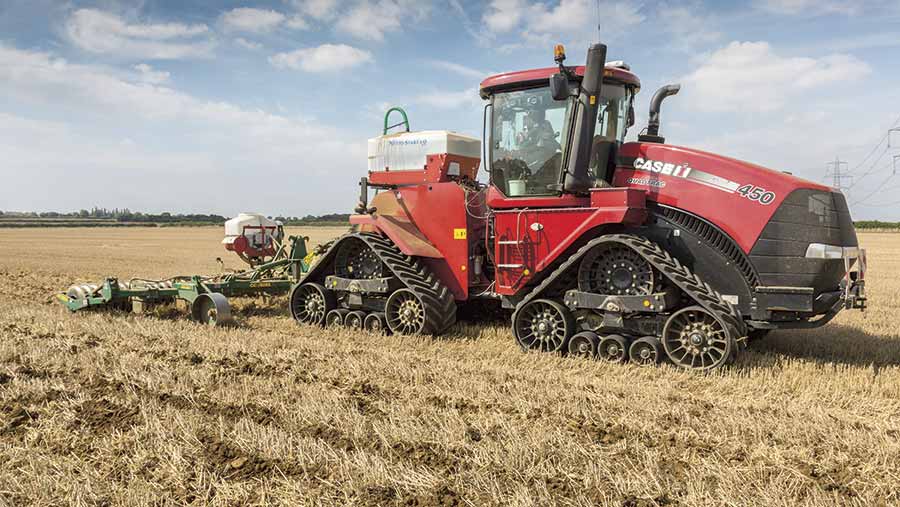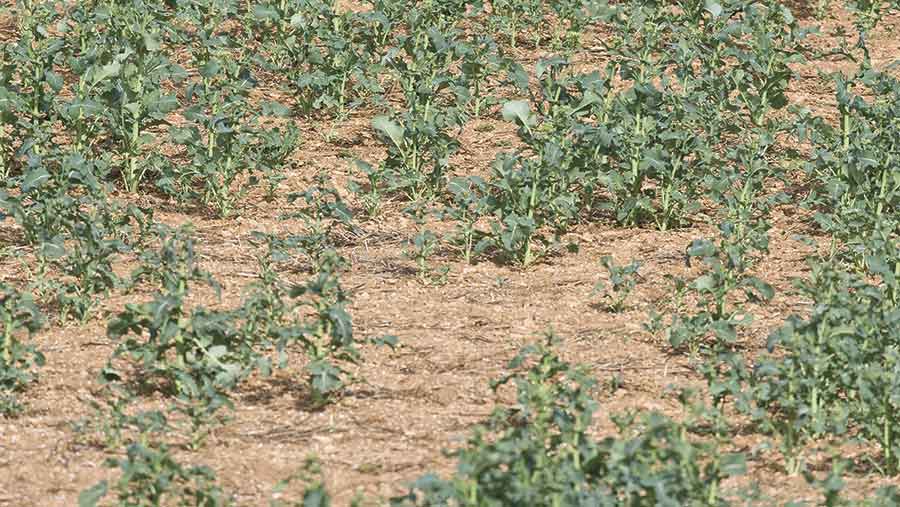How to reduce the risk of costly OSR crop failures
 © Tim Scrivener
© Tim Scrivener Last autumn saw more than 8% of the British oilseed rape crop area fail because of the toxic combination of dry autumn conditions and flea beetle attacks.
This left many businesses with the expense of re-drilling fields or establishing a spring crop instead.
There are other reasons for crop failures in more normal years, such as heavy slug or pigeon damage, however, the most costly failures are those that happen in spring after the crop has already received a large chunk of the total spend.
See also: 8% of British rapeseed crop lost to flea beetle and drought
So what can farmers do to reduce the risk of costly crop failure? A good starting point is to consider why rapeseed crops fail in the first place.
A key factor is that small-seeded crops such as oilseed rape are inherently tricky to establish, as the seed has less energy reserves and, as a result, seedlings are more sensitive to poor environmental conditions such as dry, cloddy seed-beds and infertile soils.
The critical stage of establishment is between emergence and 2-3 true leaves, and if slowed by poor conditions, crops are susceptible to attack from pests such as slugs and flea beetles.
Poorly established, backward crops can then also allow weeds to establish and diseases such downy mildew to take hold, slowing crop growth development. Thinner stands also make it easier for pigeons to land and graze during the winter.
All these factors can decimate a crop, either in isolation or combination, and cause partial or complete crop failure across a field.
Analysis of the Gatekeeper data (see “Crop data reveals impact of drilling date”) seems to back up the perception that drilling a crop as “early” in the last three weeks of August reduces the risk of crop failure, with that risk increasing considerably thereafter.
Farmers Weekly asked three agronomists from differing regions how the analysis relates to their experiences and they offer some advice on how to reduce the risk of oilseed rape failure after establishment.
South – Steve Cook, AICC/Hampshire Arable Systems

From Hampshire into the West Country, independent agronomist Steve Cook also sees earlier-sown crops as less risky, but is comfortable drilling until around 10 September in more open southern seasons.
Whatever the drill date, he highlights the importance of establishment method and is advising his clients to consider using a drill rather than cruder methods, such as autocasting or sub-casting, for more accurate seed placement.
A trend towards these cheaper methods started when rapeseed prices were low, but with the price picking up there is an economic case for investing in more reliable establishment techniques.
This is reinforced by the rise in flea beetle pressure away from eastern hotspots and the ever-present threat of slug grazing, so rapid and even establishment is more critical than ever to ensure plants are less vulnerable to attack.

“It’s safety in numbers. If a crop comes up as quickly and evenly as possible, plants won’t be picked off one at a time,” explains Mr Cook.
“The uneven depth of seed placement with sub-cast systems can leave a three-week gap in emergence between plants, which is exacerbated in dry conditions. My advice to growers is to do the job right the first time and failure is much less likely.”
Seed size
Early vigour is also vital and although the data hints at a small advantage when growing hybrid varieties, from experience Mr Cook isn’t convinced it is significant enough to favour them over conventional types.
Instead, he says seed size is the most important consideration for growers, with larger seeds having more vigour and producing a bigger cotyledon more resilient to pest attack.
An average thousand seed weight for rapeseed would be 4-5g/1,000 seeds, while a bolder sample would be up around 6-7g/1,000 seeds.
“My feeling is the larger the seed, the better, and not using a seed dressing will help, as they can all delay emergence,” he adds.
If home-saving it is possible to dress out the smaller seed, but where buying in certified, size can vary depending on the season.
Where it is on the small side, Mr Cook says planting earlier into more favourable sites and paying attention to seed-bed conditions will help compensate for any reduced vigour.
East – Ryan Hudson, Farmacy

Hertfordshire-based Farmacy agronomist Ryan Hudson has changed his advice as risk of failure in later-sown oilseed rape crops has increased over recent seasons.
For several years, his ideal window for establishment was mid- to late-August, with a cut-off date at the end of the first week of September.
However, he has seen later-sown fields struggle or even fail in the face of dry conditions and increase flea beetle pressure.
This has led him to conclude that early drilling is the right path for more reliable establishment, although he notes that drilling date will still very much depend on seed-bed conditions.
“This season, I have said to my growers that once 7 August arrives and there is enough moisture, get on and drill. The cut-off date would be 20 August – beyond that and it’s getting more risky.
“My view is if you can get the crop to its first true leaf by the end of August or the first week of September, you give it the best chance to get away. Two leaves would be even better,” he explains.
Taking this approach attempts to get plants as big as possible ahead of peak adult flea beetle migration, which is typically in early September, but can vary from season to season.
Site selection
Adding to an early drill date, Mr Hudson is also advocating a more pragmatic approach to site selection, dropping total oilseed rape areas and urging growers to only drill into kinder soils.
While the early drilling into more fertile sites can result in thicker canopies if conditions are favourable, he says this is a problem he is happy to deal with.
“It will keep the pigeons off and we have good plant growth regulator fungicides these days. I’d rather be holding back a big crop than trying to push a small crop on,” he explains.
Mr Hudson applies all the basic rules to speed up establishment, such as fine and firm seed-beds and correct nutrition, but says herbicide use in previous cereal crops should also be considered.
Where late applications of sulfonylurea products such as Atlantis/Pacifica (iodosulfuron + mesosulfuron) or Ally Max (metsulfuron + tribenuron) have been made, residues can remain in the top inch of soil if not ploughed or mixed in by deep cultivations.
In these situations, he advocates planting herbicide-tolerant Clearfield varieties, which can grow through residue unchecked.
“When a non-tolerant variety picks up the herbicide it can really slow the crop down until it gets its roots below the residue and gets away, but Clearfield keeps going,” he adds.
North – Patrick Stephenson, AICC/Niab Tag

Based in North Yorkshire, Niab Tag regional agronomist Patrick Stephenson says drilling rapeseed past 7 September dramatically increases risk of failure and tweaking rotations can help ensure timely drilling.
Winter barley is a crop struggling to justify its place in drilling plans as feed prices are on the floor and margins slim compared to second wheats, which may increase in area this autumn.
The spring barley craze is set to continue where grassweeds are a problem, but both wheat and spring barley fit into the same combining window and can push rapeseed drilling back into late August or early September.
Mr Stephenson says that growers may have to accept winter barley’s lack of profitability to aid the early establishment of oilseed rape, which is so critical to its success.
“You have to look at the rotation as a whole and it might be more profitable including some winter barley, as it enables you to control your timings and get the crop away as quickly as possible,” he adds.
Robust seed rates
Mr Stephenson also advocates the use of robust seed rates to ensure enough plants make it through the winter and produce a reasonable crop at harvest, particularly when planting into September.
Many of his clients are growing conventional varieties from home-saved seed and aim for a plant population of about 50 plants/sq m, although Mr Stephenson says he has seen good crops produced at 30 plants/sq m.
In ideal conditions, seed rates can be 5-6kg/ha but, where drilling later into poorer seed-beds, this is upped to 8kg/ha, which at 50% survival would achieve the 50 plants/sq m target.
It is a similar story with hybrid varieties, with drill coulters blocked off to concentrate seed down the row, or seed rates increased overall by 10-20% where conditions are less than ideal.
“It is chancing the arm in the hope that the crop will survive the winter and, in my experience, the poorer September-sown crops are a disaster,” says Mr Stephenson.
He concedes that sometimes he will make the decision to rip up crops and re-drill an alternative crop too early.
However, with oilseed rape potentially costing the grower up to £400/ha in establishment and input costs before Christmas, it is a big risk to continue with a struggling crop and no guarantee of success in the spring.
Reducing risk of oilseed rape crop failure
The reasons for oilseed rape failure will vary regionally and locally, but the three advisers agreed on several key considerations to improve chances of crop survival and a decent return at harvest. Here are their top tips.
Earlier is better – If seed-beds and soil moisture are adequate, the crop should be drilled through August to produce large, resilient plants as quickly as possible. Winter barley as a rotational tool can help.
Consider establishment method – Crude methods such as sub-casting can produce mixed results, so consider using the farm’s seed drill for more even seed placement and consolidate seed-beds for better soil-to-seed contact and slug control.
Source bold seed – Rather than mulling over the hybrid versus conventional question, aim to use large seed for the early vigour needed for rapid establishment. Where seed is smaller, pay extra attention to seed-bed conditions.
Use robust seed rates – Aim for 50 seeds/sq m for hybrids and 80-100 seeds/sq m for conventional varieties. Consider using wider spacing for hybrids to increase seed rate down each linear row to allow for poor seed-bed conditions or pest attack.
Give crops a kick-start – Where set-up for the use of starter fertilisers, place some di-ammonium phosphate or equivalent with the seed, or alternatively apply 30kg/ha of N to the seed-bed immediately after drilling. Organic nutrient sources, such as farmyard manure, sewage sludge and digestate, can be used where available, applied ahead of seed-bed preparation.
Consider Clearfield – Already a useful tool for dealing with problem brassica weeds, Clearfield can also provide faster establishment where acetolactate synthase (ALS) inhibitor herbicide residues from the previous cereal crop could be an issue.
Remove volunteers – The early removal of volunteers will reduce creating poorly established areas that can offer an easy landing for pigeons.
Crop data reveals impact of drilling date
An in-depth investigation of growers’ oilseed drilling habits by examining aggregated crop recording data has reinforced the perception that crops established in August are significantly less prone to costly crop failures later in the season.
Gatekeeper analysts looked at data between 2011 and 2016, identifying 19,848ha that had failed. This equates to about 1.2% of the total sample area.
Unsurprisingly, oilseed rape drilling peaked in the second and third weeks of August and then falls away towards the end of September and into October (Fig.1).
However, Fig.2 shows that the percentage of crops that failed in each drilling week was highest in the second and third weeks of September.
Earlier-sown crops tend to be written off in the autumn, with the later planting dates running into the spring before being labelled as “failed”, as seen in table below.
Later-planted crops tend to fail the following year |
|
|
Drilling dates across all years |
Month failed |
|
5 August |
October |
|
12 August |
September |
|
19 August |
September |
|
26 August |
October |
|
2 September |
September |
|
9 September |
October |
|
16 September |
April |
|
23 September |
May |
|
30 September |
May |
|
Source: Gatekeeper |
|
When comparing failures for hybrid varieties versus open-pollinated conventional types, it is difficult to find significant differences.
However, Fig.3 does seem to hint at slightly less risk from planting hybrids when considering all failures across all drill dates.

